The devil’s in the details, they say. And nowhere is that more true that with the addition of what could be considered the most innocuous performance-enhancing part out there, a K&N Filter. It’s hard to tell by just looking at your cold air kit or filter element, but there’s a whole lot of technology, research and development and execution infused in each and every unit.
The worn and tired adage that “your engine is big air pump” is never more applicable than here. K&N pours more time and effort in getting your engine the most oxygen it can process while keeping it clean and safe than all its detractors, mimics and doppelgangers.
It’s More Than Just a Familiar Name
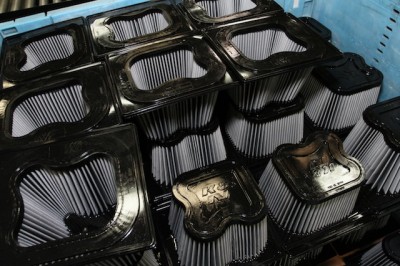 Undoubtedly, K&N is a big – if not the biggest – name in the reusable cotton gauze air filter industry. Be it producing private-labeled filters for production cars, trucks, and motorcycles or offering their immediately recognizable easy-breathing kits for your ride over parts counters across the planet, K&N is as recognizable as Snap-On Tools and Mobil Oil.
Undoubtedly, K&N is a big – if not the biggest – name in the reusable cotton gauze air filter industry. Be it producing private-labeled filters for production cars, trucks, and motorcycles or offering their immediately recognizable easy-breathing kits for your ride over parts counters across the planet, K&N is as recognizable as Snap-On Tools and Mobil Oil.
Inside its massive Riverside, California complex, K&N produces 100-percent of its product in house with 550 people dedicated to its main production line working two shifts five days a week.
This aggressive work schedule allows for K&N to fulfill its massive workload. The multi-building facility is not only comprised of a central assembly, shipping, and office, but is also flanked by a special projects/prototype facility, a comprehensive engine dynometer and speed shop, research and development department with its own set of auto chassis and motorcycle dynos, an autoclave for carbon fiber molding, and two metal shops.
This family-owned business started over 40 years ago is a worldwide juggernaut with satellite offices in both the UK and the Netherlands. We took a tour of K&N’s monstrous complex with K&N’s Tim Martin and were impressed with what we saw.
Prototypes and Pleaters
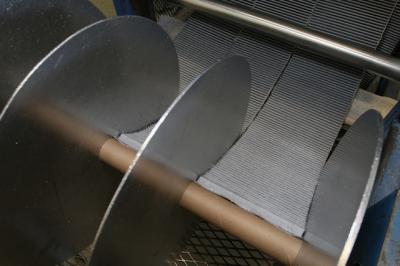 Martin explained, “Before any filter is manufactured en masse, it goes through the wringer of testing and development.” These testing prototypes are manufactured in low-rate production looms dubbed “Pleaters.”
Martin explained, “Before any filter is manufactured en masse, it goes through the wringer of testing and development.” These testing prototypes are manufactured in low-rate production looms dubbed “Pleaters.”
Manufactured completely in-house by the K&N machine shop, K&N’s pleater machines automatically weave either four or six-ply cotton filters, pressing them together and crimping the one of over 500 different pleat and ply style combinations.
“These machines are capable of ranging the pleat height from 3/8-inch to 1 1/2-inch,” Martin continued. Best of all, thanks to K&N’s wire meshing, no glue is ever used in bonding the multi-ply gauze filters. Since the pleaters are used in such low volume, they are also used to create custom and/or unique applications.
Inside of its limited-run building, K&N also manufactures its large truck and machinery filters. These can stand up to 4-feet in height and are designed specifically for heavy machinery like one would find at a construction yard. As each filter’s performance varies in part to its intended application, K&N combines its use of materials and database of testing results to engineer a filter that will best fit the engine’s requirements for optimal performance.
In The Big House
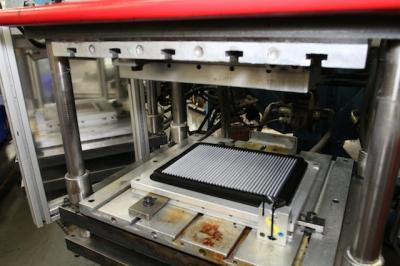 Inside of K&N’s central building is the heart of the company’s production, manufacturing, and shipping as well as its management, marketing, and business offices and its fully-staffed call center which fields over 100,000 calls a year.
Inside of K&N’s central building is the heart of the company’s production, manufacturing, and shipping as well as its management, marketing, and business offices and its fully-staffed call center which fields over 100,000 calls a year.
Adjacent to a machine shop filled with rows of a dozen CNC machines autonomously dolling out custom CAD-engineered billet pieces for one-off applications and bits and pieces for more of its many machines resides K&N’s filter assembly network of conveyors, pneumatic air lines and plumbing pumping the two part chemical compound to each of the assembly stations.
Part of the logic in not gluing the multi-ply cotton gauze together – apart from ensuring the best ventilation – is using K&N’s injection molding process to bond all the layers together. Each of the numerous filter assembly stations employ a heated table base where the cotton filter is fixed before a two-part polyurethane compound is injection molded into the jig.
Since K&N has upwards to 1,500 different sizes and designs, many of the 15 “carousel” assembly stations have been either solely dedicated to assembly K&N’s more “higher demand” filters or have been engineered to allow for multiple configurations. “The two-part polyurethane typically cures within minutes of being applied,” Martin showed us. For filters with larger bases or a secondary cap, they are oven-cured for 15-to-20 minutes.
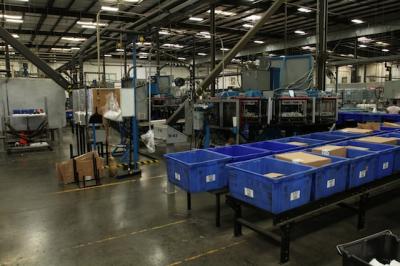 Once cured, each filter is then relocated to the oiling station. The filter is automatically sprayed with the iconic red-hued filter oil, then sealed, packaged and labeled. The system is so efficient that upwards to 30 air intake kits can be assembled at a time.
Once cured, each filter is then relocated to the oiling station. The filter is automatically sprayed with the iconic red-hued filter oil, then sealed, packaged and labeled. The system is so efficient that upwards to 30 air intake kits can be assembled at a time.
Once complete, each unit is sent to the giant “Pick Module.” A three-story building within the central K&N complex, the Pick Module is a massive automated storage and sorting network that looks like the baggage conveyor system at a major airport.
Developed and constructed by K&N Filters, the edifice regularly operates at a comfortable 75-to-80-percent capacity, manned by seven different kinds of operators. As an order comes in, the product (stored in one of over a thousand big blue bins), which has been assigned a number and stored on an assigned rack, is pulled from its place, confirmed, and forwarded – via a belt-driven conveyor system – to the shipping floor of the Pick Module.
There, it is marked, crated and shipped via one of the dozen shipping docks at the back of the building. Almost a massive mechanical digestive system, the Pick Module is a flurry of activity at nearly all times.
Extracurricular Activities
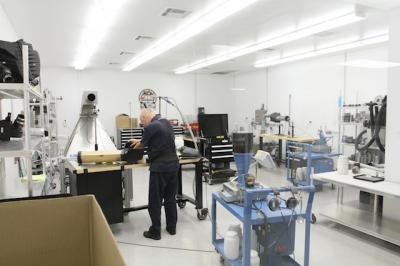 There’s a lot more than just air filters coming out of K&N’s compound. In the shadow of the massive central building sit a sequence of smaller, specialized shops which house possibly some of the coolest best-held secrets of K&N Filters. Apart from housing a selection of race cars from a variety of different modes of competition, the K&N Race Shop also has a fully-functional engine dyno.
There’s a lot more than just air filters coming out of K&N’s compound. In the shadow of the massive central building sit a sequence of smaller, specialized shops which house possibly some of the coolest best-held secrets of K&N Filters. Apart from housing a selection of race cars from a variety of different modes of competition, the K&N Race Shop also has a fully-functional engine dyno.
Used primarily as a source of top tier high performance air flow testing on a selection of different powerplants, Martin showed us around the engine dynometer room, which is unique in that it employs a ISO 1511 machine which meticulously regulates the incoming air’s temperature, humidity, and particulate count, providing the K&N engineers a gauge on their filter’s restriction versus filtration. Striking that balance, K&N uses these tactics to measure particulate levels to the nth degree with their “calibrated, engineered dirt.”
Next door is K&N’s carbon fiber molding building. Center to this is a giant autoclave. Used for optimal molding, the vacuum process removes any air bubbles from the curing process, leaving flawlessly smooth carbon fiber surfaces. While K&N doesn’t market a lot of its carbon fiber components, many are found on professional racers’ cars, like Pro Stock hood scoops, air scoops, and end plates.
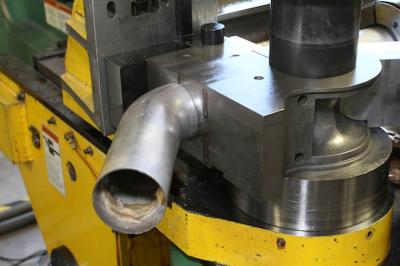 “While the major part of K&N’s success stems from its air filtration product line, K&N also supplies OE manufacturers and aftermarket companies with a great deal of private-labeled parts including mandrel-bent exhaust systems and cold air intakes, as well as offering its own in-house powder coating services,” Martin continued.
“While the major part of K&N’s success stems from its air filtration product line, K&N also supplies OE manufacturers and aftermarket companies with a great deal of private-labeled parts including mandrel-bent exhaust systems and cold air intakes, as well as offering its own in-house powder coating services,” Martin continued.
Inside K&N’s metal shop and machine shop buildings, fabricators crank out over 15,000 different parts a week as CNC and mandrel benders noisily twist and reshape aluminum tubing for complete or cat-back exhaust systems.
A few hundred feet away, a trio of K&N’s chassis dynos sit on the other side of a swinging door to the trial test and product development garage. Here, engineers get their hands on new or unique cars and design – by hand – how a cold air kit would best fit the engine bay. Here, rough discolored kits are pieced together like Erector sets before a refined prototype tube is fabricated. In fact, most of all of K&N’s cold air kits start in this very room.
On The Way Out
While K&N didn’t want to reveal all of its secrets, they were amazingly forthcoming with peeling back the curtain and letting us see how possibly the most underrated performance part on our cars are made. The forty-year-old company that traces its humble roots back to off-road desert racing is now one of the world’s most prestigious aftermarket entities, even sending off a single shipping container to Europe every week. But it’s not just the quantity that makes K&N’s name synonymous with added performance, but its willingness to put that very name on each product’s lifetime guarantee, and that level of commitment is rare these days.

















































